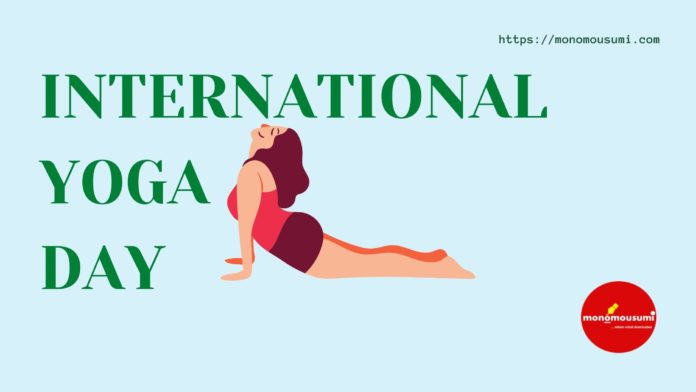“Yoga is a light which once lit will never dim, the better you practice, the brighter your flame.”
Man is a member of the vast and diverse animal world that exists on the earth from millions of years. We, humans have modified and changed many great things as per our own needs and satisfication. Humans beings with their skill, technology and hard work have achieved many great feats in all the fields of science and aerospace and wherever we went. To maintain the historical significance of these days, we observe them as ‘special days’ to remember the great contributions made by our leaders, workers, our fore fathers and ancestors who wrote the history of mankind. Some of these special days that we celebrate are as follows: Earth day, Book day, International Yoga Day, Father’s Day, Mother’s Day, Children’s Day and so on. We will find that the list is endless. In today’s modern world, these special days play a very important role in our lives. These celebrations bring peace, joy and harmony to the humanity, and they also help in breaking the monotony of life. Apart from all these celebrations, these days also have a great deal of historical and cultural importance and it represents the visions of our fore father’s who have contributed a lot to world peace and prosperity. Some of these days also reminds us of the rich cultural traditions that were being handed over generation to generation for mental and physical well-being for the individual and for the society as a whole. One such special day is the International Yoga Day which is observed on the 21st of June every year. It is a day to promote peace and harmony among all mankind. On this day, people all over the world practise yoga for better health, happiness and prosperity. Before we go further into the history and many interesting aspects of yoga and the formation of the International Yoga Day, let first have a basic understanding about yoga all with a few interesting facts about it.
Introduction to Yoga:
Now, let us know more about this beautiful cultural tradition and an ancient art which have been handed down from our ancestors who lived thousands of years before we were even born! Yoga is believed to be an ancient art that has been originated in India in the Pre-Vedic Era about sixty thousand years ago! It is surprising that we are still following the rich cultural traditions which have been handed down from generation to generation. Yoga is considered as the most favourable method to connect the individual to nature by balancing the mind and body connections.
This famous exercise called Yoga is the type of activity performed through the balanced body and free mind and the soul of the individual connecting himself with the inner being and beautiful nature. In today’s busy life of tensions and frustrations, practicing yoga daily is like a boon that provides us such a healthy and active body physically and mentally too. Yoga is the most famous exercise for everyone’s life as it helps in balancing the relationship between body and mind and that’s how we stay healthy by doing yoga. The main theme of Yoga is the connection of the individual with himself and the society. It’s the basic foundation on which the entire meditation of Yoga is built upon. It can become a physical and mental discipline of a person through regular practice. It is a form of exercise that gets better each time you practice it. Earlier, people who lived thousands of years before us were used to practicing yoga and meditation in their daily lives to live healthy and active their whole life. However on the other hand, the practice of yoga was declined day by day in such a crowded and hectic environment in which we are all living now.
More information About Yoga:
Yoga is a very safe kind of practice or meditation that can be practiced by anyone anytime it can even be done by children and old aged people to take all its benefits for free-of-cost. Yoga is a type of practice which can be performed to maintain a balanced body and to practice it you need to get full control over your diet, breathing, and physical posture. It is being known that earlier people who belonged to ‘Buddhism,’ and ‘Hinduism’ was used to Yoga and Meditation since ancient times. It was originated in India (also known as Bharat in those times), and the word Yoga is initially originated from the Sanskrit word called ‘Yuj’, which has two different meanings one is ‘Union’, and another one is ‘Discipline.’ Practicing a few Yoga steps daily teaches us how to unite or connect both Physically (Body) and Mentally (Mind). The yoga that helps to increase the memory power is called as ‘Raja Yoga’ and the yoga for physical well-being is called ‘Hatya Yoga’.
It is strongly recommended that yoga should be practiced early morning for being close to nature. It is being practiced by Hindus, Buddhas and Jains since the Early Vedic period, and they found it as a fantastic way of exercise that makes life better by controlling the mind and body. Yoga is not only an exercise but it is also a Science of living a healthier life and for long life. And many facts and experiences of great people also show that yoga works as medicine and can gradually treat and cure almost every disease. Here are some of the great facts of yoga that help to fight many incurable diseases and stay healthy forever:
- It helps to make any non-functional body part of the patient suffering from a particular disease to getting again functional, which is a massive buff and great help for our Modern Medical Science. It is a practice and a tradition that includes controlled body parts and breath.
- It also strengthens the inner and outer bodies of the individual by connecting them to Mother Earth’s natural beauty and it cannot only be said as a physical practice, but it helps humans to get control over their mental, emotional and spiritual thoughts.
- It is a very easy method which requires only controlled slow and safe movements of the body with normal and controlled breathing. To make people aware of yoga and its benefits all over the world, an International level event suggested by Prime Minister of India Shri Narendra Modi and has been declared by United Nations General Assembly’s President Sam K.Kutesa to celebrate it annually on 21st June and called it as International Yoga Day.
From the last few couple of years, yoga has become a popular form of exercise all over the globe, but our Indian community who were the founders of this beautiful tradition had almost forgotten it.
Still then, a great Swami named Baba Ramdev who had clear knowledge of this tradition introduced it again in India and many other countries across the world. Yoga is very beneficial exercise which also helps a person to get higher consciousness by gaining control over the Physical (Body) and Mental (Brain) movement. It has been proven that yoga is capable of curing many fatal and worst diseases, including Cancer, Diabetes, High or Low Blood Pressure, Heart Alignment, Kidney and Liver Disorders, and a variety of mental and physical problems. It is seen that yoga is replacing the medicines consumed by people daily, which has a profound effect on the number of unhealthy people, which is gradually decreasing day by day. Because of introducing this beautiful exercise called yoga as similar to other activities, most of the school and organization have a separate class of Yoga and some other physical activities. Yoga is also a very good meditation which helps to sharpen the mind and improves intelligence and helps in a high level of concentration by steading the feeling and the painful emotions, which is most disturbing in the human brain.
Yoga is not only an exercise but it is like a medicine that offers a great deal of benefits for our health, body and mind. Here are some of the great health benefits of yoga which have helped people over millions of years:
- It is very beneficial and helpful in improving the flexibility of muscles.
- Correcting the posture of our body.
- It helps to digest the food that we eat by secreting enzymes that help in the breakdown of food.
- Helps to reduce our body weight by burning the fats.
- It helps in the clotting of blood and thereby protecting us during the time of injury.
- It makes our skin glow.
- Improves the circulation of blood in our body.
- Improves muscle relaxation.
- It helps to keep our mind our body stress-free and active.
- Last but not the least, yoga is a very good exercise to help in connecting you with your inner being and the society around you.
These are just a few of the variety of benefits that yoga gives. Rather than these, there are many other uncountable benefits of yoga.
Classification of Yoga:
Yoga is classified in Four Parts which are as follows:
KARMA YOGA
JNANA YOGA
BHAKTI YOGA
KRIYA YOGA
- Karma Yoga: Karma Yoga which is also known as the Discipline of Actions in the western culture is one of the four essential pathways of yoga. This pathway of yoga teaches us to perform one’s duty without getting attached to the world or in the greed of any reward by doing selfless activities and responsibilities.
This is the first and the main lesson that is being taught to Karma Yogis. It is specially for those who seek the spiritual path and union with God alone.
It is also a yoga which can also be practiced in our daily routine by helping others without expecting any reward.
A life of any individual on the earth is governed by his Karma cycle as if a person having good thoughts, right actions, and kind words will probably lead to having a happy and beautiful life after his death because he will be free from the cycle of birth and death whereas a person having evil ideas, evil effects, and bad words will likely cause bad things to happen to us.
- Jhana Yoga: It is popularly known as the Wisdom Yoga. Jhana Yoga is the most challenging and complicated path among all.
It teaches a person to merge with inner being which is on the inside of him by practicing various mental techniques by meditation into the deep conscious mind and conducting self-questioning sessions.
This path teaches to steady the mind, body and emotions by focusing on six fundamental virtues – calmness, control, and sacrifices, tolerance, faith, and focus.
It is strongly advised to practice the Jnana Yoga under the guidance of a competent and experienced guru to achieve their goals in life.
- Bhakti Yoga: It is also known as the Spiritual or Devotional Yoga which is mostly practised in India. It is associated with divine love for God alone as it is the most significant pathway to spiritual enlightenment through love and devotion. In this path, an individual sees God in his life as praise or bhajans and engaging in worship and Rituals. It is the easiest and most popular yoga ever practiced. It leads to purification of our heart and mind. It also plays a major role in developing compassionate feelings and focusing on purifying the inner self.
- Kriya yoga: It is the physical practice of yoga in which several body postures are performed through meditation techniques of energy and breathe control.
Under this type of yoga the development of body, mind and soul takes place. By practicing this yoga system, the entire human body can be energized and made active in a short period. All the necessary hormones and enzymes are secreted by our body during this period which makes a person feel refreshed and energetic.
BRIEF CULTURAL HISTORY AND DEVELOPMENT OF YOGA:
Yoga’s rich cultural traditions and history has many places of obscurity and uncertainty due to its oral transmission of sacred texts and the secretive nature of its teachings. The early writings on yoga are believed to have been transcribed on fragile palm leaves that were easily damaged, destroyed or lost due to harsh weather and climatic conditions in the long run. The development and progress of yoga are often traced back to over 5,000 years ago during the Pre-Vedic Era, but some researchers think that yoga could also be up to 10,000 years old practice in India. Yoga’s long and rich cultural history are often divided into four main periods of innovation, practice and development over many years.
Pre-Classical Yoga
In the beginning, the practice of yoga was developed by the Indus-Sarasvati civilization in Northern India about 5,000 years ago. The word yoga was first mentioned within the oldest sacred texts in the history of the Vedas and the Puranas, the Rig Veda. It is said that the Vedas were a collection of sacred religious texts containing songs, mantras and rituals to be used by Brahmans who lived a complete religious life, the Vedic priests. The history of Yoga was slowly refined and developed by the Brahmans and the Hindu Rishis (mystic seers) who documented their practices and beliefs within the Upanishads and other sacred texts, an enormous work containing over 200 scriptures. The most renowned and written of the Yogic scriptures is known as the Bhagavad-Gita which was composed around 500 B.C.E. The Upanishads took the thought of formality sacrifice from the Vedas and the other religious scriptures and internalized it, teaching the sacrifice of the inner evil called ego through self-knowledge, action (karma yoga) and wisdom or bhakti (jnana yoga).
Classical Yoga
In the pre-classical stage of development and historical progress, yoga was indeed a mishmash of various ideas, beliefs and techniques that often conflicted and contradicted each other in the long run. The rich Classical period of Yoga is defined by Patanjali’s Yoga-Sutras which was the primary systematic presentation of yoga in those times. Written a long while within the second century, this text describes the trail of the most famous and popular yoga known as the Raja Yoga, often called “classical yoga”. It is being widely spoken by people that Patanjali organized this practice of yoga into an “eight limbed path” containing the steps and stages towards obtaining Samadhi or the enlightenment to eternal and everlasting salvation or moksha from the cycle of birth and death. That’s why Patanjali is usually considered the father of yoga and his Yoga-Sutras still strongly influence most sorts of modern yoga.
Post-Classical Yoga
A few centuries after the great Yogic sage Patanjali, yoga masters created a system of practices designed to rejuvenate the body of the person who practices yoga and prolong life. They rejected all the teachings of the traditional Vedas and other religious scriptures and embraced the human body because the means to realize the true concept of enlightenment. They developed a new Yoga called Tantra Yoga, with radical techniques to cleanse the body and mind to interrupt the knots that bind us to our physical existence on this Earth and in heaven. This exploration of those physical-spiritual connections which were mentioned and body centered practices led to the creation of what we primarily consider as yoga within the West: The great yoga.
Modern Period
It is said in the Hindu Scriptures that in the late 1800s and early 1900s, yoga masters began to visit the West, attracting attention of the people towards and followers of Yogic Masters. This practise by the Masters actually began at the 1893 Parliament of Religions in Chicago, when Swami Vivekananda, the great Master of Yoga wowed the attendees together with his lectures on yoga and therefore the universality of the world’s religions. In the late years of 1920s and 30s, yoga was strongly promoted in the whole of the Indian Subcontinent with the work of T. Krishnamacharya, Swami Shivananda and other yogis practicing the famous Hatha Yoga and teaching others about the same. T.Krishnamacharya was the first person who opened the primary yoga school in Mysore in 1924 and in 1936 Shivananda founded the Divine Life Society on the banks of the holy and sacred Ganges river. Krishnamacharya produced three great Yogic students that might continue his legacy and increase the recognition of Hatha Yoga for the generations to come. These three students are as follows: B.K.S. Iyengar, T.K.V. Desikachar and Pattabhi Jois. Shivananda was a prolific author, writing over 200 books on the rich cultural history of yoga, and established nine ashrams and various yoga centers located around the world where yoga is still being widely practiced.
The importance of the culture of yoga to the West still continued at a trickle until Indira Devi opened her yoga studio in Hollywood in and it was at that time that the popularity of yoga grew to its peek. Since then, more and more western and Indian teachers became pioneers, popularizing yoga and gaining many followers who practiced Yoga with them. Today, Hatha Yoga is the most Popular yoga which has many various schools or styles, all emphasizing the various different aspects of the practice even in the modern world.
Yoga- The best exercise for Mental and Physical Well-being:
As a famous quote extended from a long time ago, “Yoga isn’t just repetition of few postures-it is more about the exploration and discovery of the subtle energies of life.” The famous word which we use called ‘Yoga’ is derived from the Sanskrit word ‘Yuj’ in verb form, which suggests to ‘unite’ or ‘join’. It is the science of development of an individual’s consciousness. It is said to be the great unification of the Atma with the Paramatma, the connection of the physical, mental and emotional aspects of the physical body of an individual person with nature.
The rich cultural practice of Yoga can be traced so far back to pre-vedic Indian traditions which have been handed down to us possibly within the Indus Valley Civilization around 3000 BCE. Its is said that ‘The Yoga Sutras of Patanjali’ date from the 2nd century BCE and gained prominence in the west in the 20th century after being introduced by Swami Vivekanand in the Bharat also called India. The mentioning of the rich culture of Yoga has been seen in several ancient also as modern texts, early references to practices that later became a neighbourhood of Yoga are made in ‘Brihadaranyaka Upanishad’ and also the Rigveda. In several chapters of Mahabharata also, Yoga covers a significant part.
An Interesting Story behind the origin and Development of Yoga:
Yoga is an ancient practice that was mainly introduced in the past for focusing on breathing, flexibility and strength to boost mental and wellbeing. It is mixed or a composed of a group of physical, mental, and spiritual practices or disciplines. The main and the prime most components of yoga are its special types of breathing and postures (a series of movements designed to increase strength and flexibility.)This common practice of Yoga, which is also known as the Common Yoga Protocol is said to have originated thousands of years ago in India and has been adapted in other countries in a variety of ways nowadays. The traditional origins of Yoga can be traced to northern India over 5,000 years ago i.e, from the ancient times. It is popularly known that the word yoga was first mentioned in the many ancient sacred texts of India called the Rig Veda. The Vedas are a set or a combination of four ancient sacred texts written in Sanskrit. The Rig Veda is said to be the earliest amongst the vedas because it is a collection of over a thousand hymns and mantras in ten chapters known as mandalas, which were used by Vedic age priests in ancient times. The culture of Yoga was refined and developed by Rishis who were the older sages who documented their practices and beliefs in the Upanishads, which is indeed a huge work containing over 200 scriptures.
Yoga is popular amongst the six schools of philosophy in the Hinduism, and is also a major part of Buddhism and its meditation practices. The first Yogi and also popularly known as the teacher of the science of yoga is Shiva. He is the mentioned as the first and the foremost teacher of yoga.
International Yoga Day for Mental and Physical Well–being:
While we have seen many great aspects about the history, origin, and the rich cultural heritage of the famous yoga, let us now dive into the main topic of this essay which is the International Yoga Day. International Yoga Day also known as Yoga Day is celebrated by the whole world on 21st June every year starting from 2015 and was initiated by the prime minister of India, Mr. Narendra Modi. International Yoga Day has been an enormous success since its launching, and huge programs are organized every year with a massive number of presents in the programs. On the first yoga day, that is, on the 21st June 2015, around 35,985 people, including the honourable prime minister of India himself, gathered at one place in Rajpath, New Delhi, and practiced near about 21 yoga poses for over 35 minutes and a new Guinness World Record was established.
The Second International Yoga Day was held in the Indian State of Chandigarh, where Mr. Narendra Modi, the prime minister of India, helped to create awareness among a large number of people about the benefits of yoga in our daily life. Thousands of people practiced yoga postures, including the prime minister himself. To encourage and inspire the mass about the benefits of yoga, Mr. Narendra Modi gave a marvellous and inspiring introductory speech on how yoga makes life better. In the year 2016, many big and small programs took place all over the country where the great Indian Navy, Indian Coast Guards, and Indian Army and almost all the citizens of the country gathered to practice yoga and this is how the International Yoga Day is celebrated with the same zeal all over the world even today.
Yoga is vital in an individual’s life as it makes his life organized and help him to keep his body fit and healthy and mind in the eternal peace. Taking pills, medicines and health supplements does not have the same effect on the body as yoga does, and that is why yoga practitioners all over the world and in India encourage others to avail and make yoga as a part of their daily routine. The International Yoga Day which was made by Narendra Modi has helped in promoting the idea and the benefits of practicing yoga and has encouraged thousands of people all over the globe to do yoga and is continuing to do the same.
Why do we celebrate Yoga Day?
PM Modi, during his speech at the UNGA, said, “Yoga is an invaluable gift of India’s ancient tradition. It embodies unity of mind and body; thought and action; restraint and fulfilment; harmony between man and nature; a holistic approach to health and well-being. It is not about exercise but to discover the sense of oneness with yourself, the world and the nature. By changing our lifestyle and creating consciousness, it can help in well being. Let us work towards adopting an International Yoga Day.” This is the main reason for the world wide acceptance of this rich cultural tradition of India which has been handed down from our ancestors and why people all across the globe have made yoga as an integral part of their lives.
Logo for International Yoga Day:
To maintain the historic significance of yoga and to promote peace and harmony among all mankind, we have designed a Logo for International Yoga Day. In the symbol, folding of both hands Symbolise the everlasting Yoga, the IYD logo union, which reflects the union of individual Consciousness with that of universal Consciousness, a perfect harmony between mind and the body, connection between man and nature; a holistic approach to health and well being. The brown leaves in the logo symbolise the Earth as an element, the green leaves symbolise the beautiful and green Nature, blue symbolises the Water element, brightness of the logo symbolises the Fire element and the Sun symbolise the source of energy and inspiration to all those who do yoga. So all together we can say that the logo reflects harmony and peace for humanity, which is the basic essence and the core on which the entire foundation of Yoga has been built.
Main Objectives of Yoga Day:
International Day of Yoga has mainly been adopted by the world to fulfill the following main
Objectives:
1. To create awareness among people about the health and natural benefits of yoga.
2. To connect an individual with himself and the beautiful nature by practising yoga.
3. To improve meditation skills of people through yoga.
4. To draw attention of the people from all over the world towards the holistic benefits of yoga.
5. To improve health and reduce the rate of health challenging diseases all over the world.
6. To bring communities and groups of people much close together to spend a day for health from the busy life schedule.
7. To enhance the growth and development of the individual and spread peace all through the world.
8. To help people face their bad situations themselves by getting relief from stress and anxiety through yoga and meditation.
9. To strengthen the global coordination among people and emphasise on unity through constant practise of yoga.
10. To make people and masses aware of physical and mental diseases caused by depression and stress and its solutions through practicing yoga.
Some Social Benefits of Yoga:
Some of the social benefits of yoga in general are as follows:
- It is widely and popularly known and proven that Yoga is very effective and is linked to lowered stress levels. This can make you better at being able to communicate and more positively interact with family, friends and co-workers and eliminate all kinds of bad thoughts and words.
- Many people who are participating in yoga classes claim that it is a great way to meet new friends with similar interests.
- Yoga is also associated with improvements in mental as well as physical health and wellness. These can make you more socially functional in various areas and fields of your life, including personal, professional and community-oriented and protects you from deadly diseases and illness.
Surveys conducted from time-to-time shows that people who practice yoga often report greater levels of happiness. Whenever you are feeling a little happy, you gain the immediate power and positive encouragement to make others around you happy. These are just a few social benefits of yoga. There are many innumerable benefits of yoga that is still to be discovered.
Now as to conclude, we have understood that yoga is not just an exercise but it is an art to improve our mental and physical well-being and the best way to relieve ourselves from stress, anxiety and depression in today’s life which is full of confusion and stress. Yoga plays very important role in our day-to-day life by keeping us happy and healthy. Yoga is actually the journey to the inner soul that connects an individual with himself and the nature which created him that is, it helps us to know more about the beauty of nature. Taking everything into consideration, International Yoga day is a very good way to encourage people to perform various Yogasanas and practice them for their mental and physical well-being. Many People across the world and many great experts have acclaimed that by performing various exercises of Yoga, their medical problems also got vanished. In addition to this great fact, by performing Yogasanas one can be relieved from stress and anxiety. A great number of people also recommend that people who are performing various lifting exercises should also perform some Yoga exercises to bring flexibility into their bodies. So it is highly encouraged that one should celebrate Yoga day to encourage a lot of other people to make yoga a very important part of their lives.
By Mathew George, Abbasiya, Kuwait
















